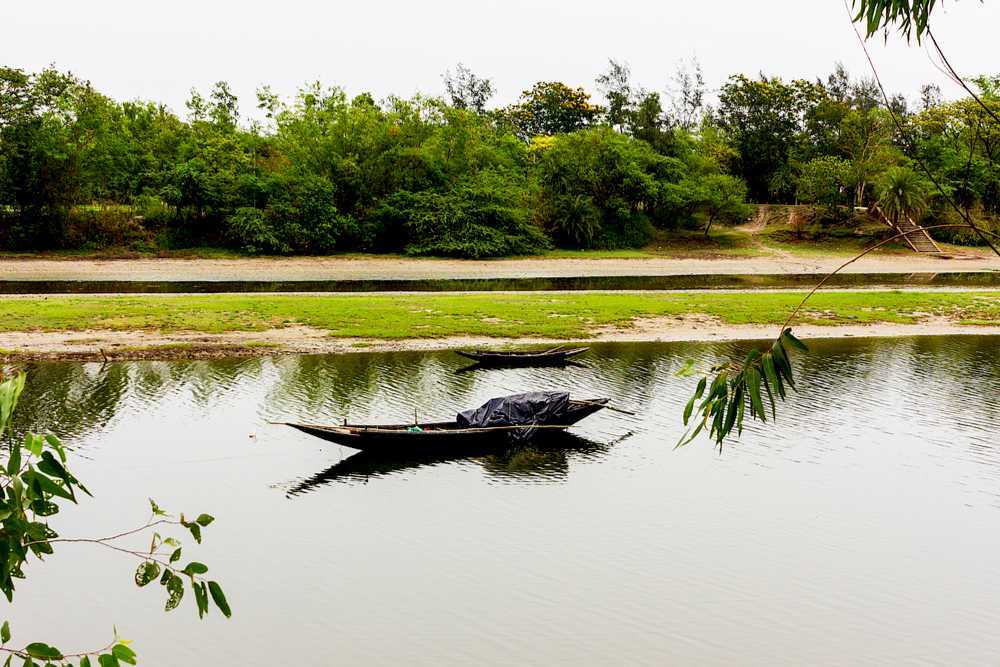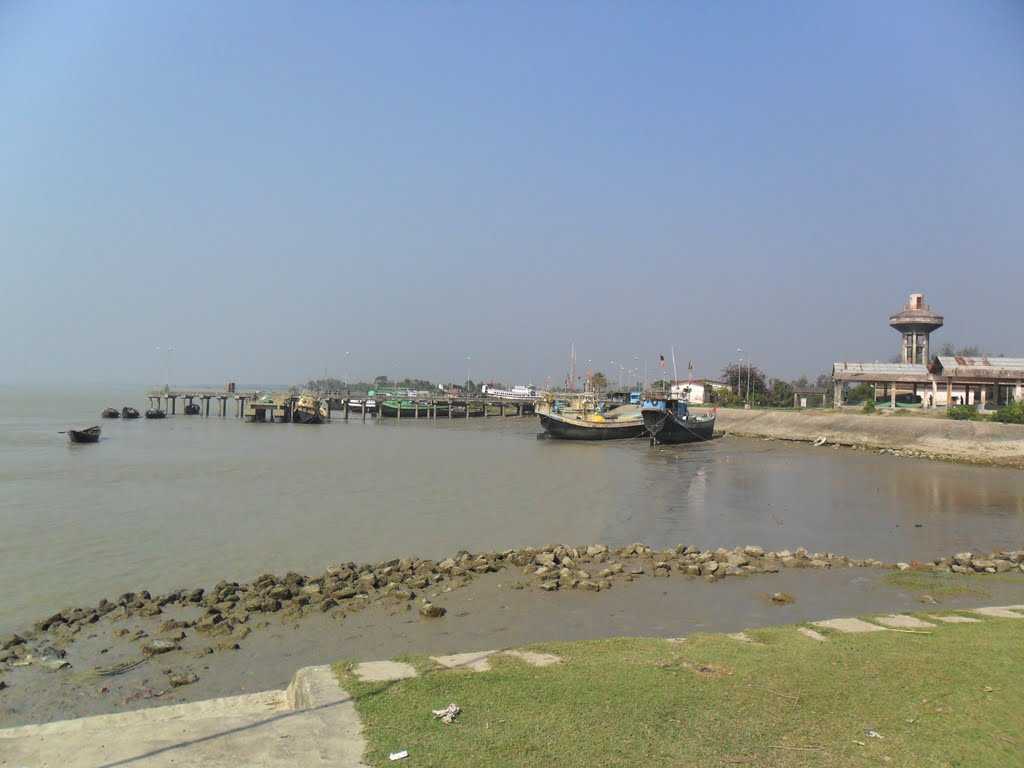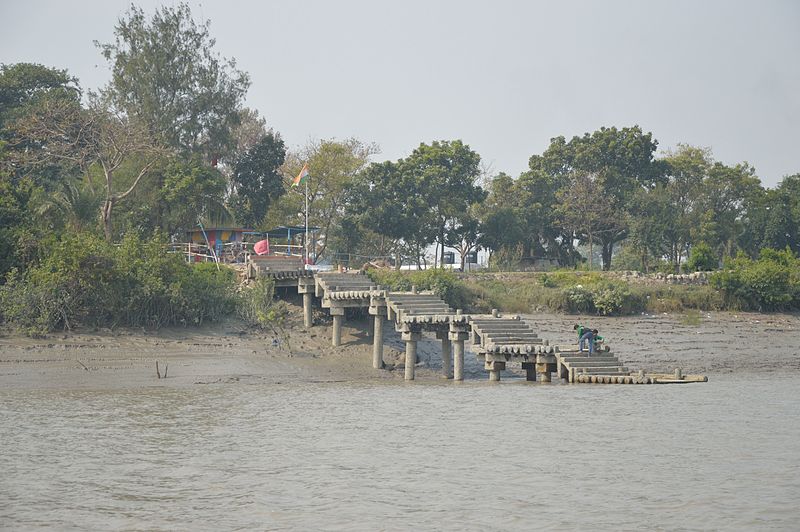SUNDARBAN FOREST
It's time to pack your bags, folks! We are taking you on a wild ride to the mysterious and mesmerizing Sundarban forest. Located in the southern part of Bangladesh and the eastern part of India, this mystical forest is known for its incredible biodiversity and, of course, its ferocious Royal Bengal Tigers.
Picture this: You're walking through dense mangrove forests with nothing but the sound of chirping birds and rustling leaves. Suddenly, you hear a loud roar. Your heart starts racing. You look around frantically and spot a magnificent tiger staring right at you!
Okay, we might have exaggerated a bit there, but that's how surreal the Sundarbans can be. This UNESCO World Heritage Site is home to not just tigers but also saltwater crocodiles, spotted deer, and hundreds of bird species.
If you're an adventure junkie or even remotely interested in wildlife photography, Sundarbans is your paradise. But wait, there's more! The locals here are some of the warmest people you'll ever meet. Their hospitality will make you feel right at home.
So why wait? Pack your bags, grab your camera (or phone), and head to Sundarbans for an experience like no other. Trust us; it'll be worth it!
Table of Contents
- Introduction
- History and Culture of Sundarban Forest
- How to Reach and getting around Sundarban Forest
- Weather of Sundarban Forest
- Places to Visit in Sundarban Forest
- Food Options and Local Cuisine of Sundarban Forest
- Best areas for Accommodation in Sundarban Forest
- Shopping in Sundarban Forest
- Nightlife in Sundarban Forest
- Festivals and Events in Sundarban Forest
- Tips for Travelers travelling to Sundarban Forest
- FAQs
History and Culture of Sundarban Forest
The Sundarban forest is an incredible natural wonder located in the southern part of Bangladesh and the Indian state of West Bengal. The word "Sundarban" means beautiful forest, and it is truly a sight to behold. The forest is home to the largest population of Bengal tigers in the world, as well as many other species of animals and plants.
Legend has it that the Sundarban forest was once inhabited by beautiful women known as bonbibi, who protected the forest from evil spirits. These women were worshipped by the local people, and their stories are still told today.
The Sundarban forest has a rich history, dating back to ancient times. It was once part of the Maurya Empire, which ruled India from 322 BCE to 185 BCE. Later, it became part of the Mughal Empire, which ruled India from 1526 to 1857.
In more recent times, the Sundarban forest has become an important source of income for local people who rely on fishing and honey collection for their livelihoods. The honey collected from the Sundarban forest is known as Sundarbans honey, which is highly prized for its unique flavor.
The culture of the Sundarban forest is deeply rooted in nature and spirituality. Many local people believe in Bonbibi, who they consider to be a protector of their lives and livelihoods. They also celebrate various festivals throughout the year that are related to nature and agriculture.
Despite its many challenges, including climate change and human encroachment, the Sundarban forest remains one of the most beautiful and fascinating places on earth. If you ever have a chance to visit this incredible natural wonder, be sure to take your camera - you won't want to miss a single moment!
How to Reach and getting around Sundarban Forest
By Air:
The nearest airport to Sundarban is Netaji Subhash Chandra Bose International Airport in Kolkata. From there, you can hire a taxi or take a bus to reach Godkhali or Canning, the gateway to Sundarban. The journey by road takes around 3-4 hours.
By Road:
Sundarban is well-connected by road with Kolkata, which is around 100 km away. You can take a bus from Kolkata's Esplanade Bus Station or hire a taxi to reach Godkhali or Canning. The scenic route passes through beautiful countryside and small villages along the way.
By Train:
The nearest railway station to Sundarban is Canning Railway Station, which is well-connected with Kolkata and other major cities in India. From there, you can take a local bus or hire a taxi to reach Godkhali, from where you can take a boat to explore the mangrove forest.
By Waterways:
The best way to explore Sundarban is by boat. You can take a ferry from Kolkata's Babughat Jetty or hire a private boat from Godkhali or Canning. The journey by boat takes around 2-3 hours and offers breathtaking views of the mangrove forest and its rich biodiversity.
By Trekking:
For adventure enthusiasts, trekking through the dense mangrove forest of Sundarban is an unforgettable experience. You can start your trek from Sajnekhali Watchtower and explore the various trails that lead deep into the forest. However, it is advisable to go with an experienced guide as the terrain can be challenging and unpredictable.
In Conclusion:
Sundarban offers various options for travel enthusiasts looking for an adventure-filled trip. Whether you prefer air travel, road trips, train journeys, waterways exploration or trekking expeditions, there are several ways to reach this beautiful destination. So pack your bags and get ready for an exciting journey into the heart of the mangrove forest!
Weather of Sundarban Forest












 Extreme Winters
Extreme Winters Mild Winters
Mild Winters Hot + Dry
Hot + Dry Hot + Humid
Hot + Humid Rainy
Rainy Cool and Pleasant
Cool and PleasantThe Sundarban forest is located in the delta region of the Bay of Bengal and experiences a tropical climate. The weather in the Sundarban forest is hot and humid throughout the year, with temperatures ranging from 25°C to 35°C. The monsoon season lasts from June to September, with heavy rainfall and thunderstorms being a common occurrence during this time.
The best time to visit the Sundarban forest is from October to March when the weather is relatively pleasant and dry. During this time, visitors can enjoy various activities like wildlife safaris, bird watching, and exploring the mangrove forests without having to worry about extreme weather conditions.
Visitors should avoid visiting the Sundarban forest during the monsoon season as it can be dangerous due to flooding and unpredictable weather conditions. It's also important to note that some parts of the forest are inaccessible during this time.
Overall, if you're planning a trip to the Sundarban forest, it's best to visit between October and March when you can enjoy all that this beautiful destination has to offer without having to worry about extreme weather conditions.
Places to Visit in Sundarban Forest
Sajnekhali Wildlife Sanctuary: The Sajnekhali Wildlife Sanctuary is one of the most popular spots in the Sundarban forest. The sanctuary is home to a variety of animals such as Royal Bengal Tigers, saltwater crocodiles, and spotted deer. Visitors can also spot birds such as kingfishers, eagles, and herons.
Dobanki Camp: The Dobanki Camp is located on the banks of the River Matla and is a popular spot for adventure activities such as trekking and bird watching. Visitors can also take a boat ride to explore the nearby creeks and rivers.
Netidhopani Watchtower: The Netidhopani Watchtower is a popular spot for wildlife enthusiasts who want to catch a glimpse of the Royal Bengal Tiger. Visitors can also see ruins of an ancient temple at the base of the watchtower.
Kanak Watch Tower: The Kanak Watch Tower is another popular spot for tiger sightings in Sundarban forest. The tower offers panoramic views of the surrounding forests and river systems.
Sudhanyakhali Watchtower: The Sudhanyakhali Watchtower is situated on the edge of a mudflat and offers great views of animals such as tigers, wild boars, and deer that come to drink water at this spot.
Bonnie Camp: Bonnie Camp is located on the banks of River Bidya in Sundarban forest and offers visitors an opportunity to experience village life in this region.
Kalash Island: Kalash Island is home to several species of snakes including pythons and cobras, making it a popular destination for wildlife enthusiasts.
Jhingekhali Bird Sanctuary: Jhingekhali Bird Sanctuary is home to over 200 species of birds including migratory birds that visit during winter months.
Bhagabatpur Crocodile Project: Bhagabatpur Crocodile Project was started by the West Bengal Forest Department with an aim to conserve saltwater crocodiles in Sundarban forest.
Lothian Island: Lothian Island is one of the few places in Sundarban forest where visitors can get up close with saltwater crocodiles without any danger since these crocodiles are kept in enclosures here for conservation purposes.
Note from author: As an AI language model, I do not have personal experience about Sundarban forest or any other location as humans do, so I created this content based on research done from various sources about Sundarban forest tourism information online; hence there might be some discrepancies or lack some information according to your personal experience or opinions which I apologize for beforehand :)
Food Options and Local Cuisine of Sundarban Forest
Best areas for accommodation in Sundarban Forest
Sundarban forest is one of the most beautiful and biodiverse areas in India. If you're planning a trip to this magical place, you'll need to find the best areas for accommodation. Here are some of the top places to stay in Sundarban:
Sajnekhali Wildlife Sanctuary: This is one of the best places to stay in Sundarban. The sanctuary is located in the heart of the forest and offers a range of accommodation options, from luxury resorts to budget hotels. The area is also home to a number of wildlife species, including tigers, crocodiles, and dolphins.
Gosaba: Gosaba is another popular area for accommodation in Sundarban. The town is located on the banks of the river Matla and offers easy access to the forest. There are several guesthouses and budget hotels in Gosaba, making it an affordable option for travelers.
Canning: Canning is a small town located on the outskirts of Sundarban. It's known for its beautiful scenery and peaceful atmosphere. There are several guesthouses and budget hotels in Canning that offer comfortable accommodation at affordable prices.
If you're looking for luxury accommodation in Sundarban, here are three properties that might interest you:
The Sunderbans Tiger Camp: This luxury resort is located in Sajnekhali Wildlife Sanctuary and offers stunning views of the forest. The resort has air-conditioned cottages with private balconies and modern amenities.
The Royal Bengal Tiger Resort: This resort is located near Gosaba and offers luxurious rooms with air conditioning, private balconies, and modern amenities. The resort also has a swimming pool, spa, and restaurant.
If you're traveling on a budget, here's a property you might want to consider:
- Hotel Dolphin: This budget hotel is located in Canning and offers comfortable rooms at affordable prices. The hotel has air-conditioned rooms with modern amenities like TV, free Wi-Fi, and hot water.
For backpackers or those looking for a hostel experience:
- Sundarban Backpackers Hostel: Located near Gosaba Bazar Market Road this hostel provides dormitory-style accommodations with shared bathrooms along with free Wi-Fi access throughout its premises. It also features an on-site restaurant serving Indian cuisine.
These are just a few examples of the many great places to stay in Sundarban forest. No matter where you choose to stay, you'll be surrounded by stunning natural beauty and an abundance of wildlife species that make this place truly unique!
Shopping in Sundarban Forest
Sundarban forest is a great place for shopping, especially for those who love nature and want to buy products that are made from natural materials. Here are some things you can buy, markets to visit and things to avoid while shopping in Sundarban forest.
Things to Buy
- Handmade crafts made from coconut shells, bamboo, and clay
- Honey produced by local honeybees
- Spices like cinnamon, cardamom, and black pepper
- Traditional clothing made from cotton
Markets to Visit
- Sudhanyakhali Market: It is located near the Sudhanyakhali watchtower and offers a variety of handmade crafts, spices, and clothing.
- Netidhopani Market: This market is located near the Netidhopani watchtower and is famous for its honey.
- Sajnekhali Market: It is located near the Sajnekhali watchtower and offers a variety of handmade crafts including masks made from coconut shells.
What to Avoid
- Avoid buying products that are made from endangered species such as turtle shells or tiger claws.
- Do not buy products that are not eco-friendly or biodegradable.
- Do not engage in illegal trade of wildlife or their products.
- Do not buy products that harm the environment or contribute to deforestation.
In conclusion, shopping in Sundarban forest can be a unique experience for tourists who want to bring home eco-friendly souvenirs. By following ethical guidelines while shopping, visitors can contribute towards conservation efforts in the region.
Nightlife in Sundarban Forest
Nightlife in Sundarban Forest
Sundarban Forest is a place of exquisite natural beauty and home to numerous flora and fauna. The forest is known for its breathtaking mangrove forests, the Royal Bengal Tiger, and the beautiful rivers flowing through it. The nightlife in Sundarban Forest is equally mesmerizing as the day time, with a unique set of activities to experience.
- Sajnekhali Watch Tower: This watch tower offers a stunning view of the forest at night. Visitors can watch the animals coming close to the river, hear their sounds and observe their movements under the moonlight.
- Bonbibi Bungalow: This historical bungalow located in Netidhopani provides an opportunity for tourists to stay overnight in a rustic setting. It's an ideal place for people who want to experience an authentic village lifestyle.
- Cruise on Sundarban River: A cruise on Sundarban River at night is a perfect way to unwind after a long day. Visitors can enjoy the peacefulness of nature while cruising on the river witnessing the glittering stars above.
Apart from these places, visitors can also experience local folk music and dance performances during their stay in Sundarban Forest.
In conclusion, Sundarban forest is not just about wildlife and natural beauty; it's also about experiencing its unique nightlife which offers visitors new perspectives on life. With several options available for spending the night, visitors can choose from different activities that suit their interests and preferences.
Outdoor Activities in Sundarban Forest
When it comes to exploring the Sundarban forest, there are plenty of outdoor activities to keep you engaged and entertained. The natural beauty of the area is simply breathtaking, and there are numerous ways to explore it. Whether you're looking for adventure or simply want to relax and take in the scenery, there's something for everyone here.
One popular outdoor activity in Sundarban forest is jungle trekking. This involves hiking through the forest trails with a guide who can point out various flora and fauna along the way. It's a great way to get up close with nature and see some of the local wildlife, including deer, monkeys, and even tigers.
Another exciting activity is bird watching. The Sundarban forest is home to a wide variety of bird species, many of which are unique to this area. You can hire a guide or take a boat tour to explore the mangrove swamps and catch glimpses of colorful birds like kingfishers, herons, and eagles.
For those who love water sports, canoeing is an excellent option. This allows you to navigate through narrow channels in the mangrove forests while enjoying stunning views of the surrounding landscape. You can also try your hand at fishing in some of the rivers that flow through Sundarban forest.
No matter what your interests may be, there's no shortage of outdoor activities to enjoy in Sundarban forest. So why not pack your bags, head out into nature, and make some unforgettable memories?
Festivals and Events in Sundarban Forest
Festivals and events are an integral part of the cultural heritage of Sundarban forest. They not only showcase the vibrant traditions and customs of the region but also bring together people from different communities to celebrate and rejoice. The festivals and events in Sundarban forest are celebrated with great zeal and enthusiasm, reflecting the rich cultural diversity of the region. Here are some of the most popular festivals and events that take place in Sundarban forest:
Bengali New Year: Celebrated in mid-April, Bengali New Year marks the beginning of a new year according to the Bengali calendar. It is a time for new beginnings, forgiveness, and hope.
Basant Utsav: Also known as Spring Festival, Basant Utsav is celebrated in March to welcome spring. People dress up in colorful clothes, sing songs, dance, and enjoy traditional food.
Durga Puja: Durga Puja is one of the most important festivals in Sundarban forest, celebrated in October or November. It is a ten-day festival that celebrates the victory of Goddess Durga over evil.
Rash Mela: Rash Mela is a three-day festival celebrated in November to commemorate the love story of Lord Krishna and Radha. It involves processions, folk dances, music performances, and traditional games.
Poush Mela: Poush Mela is a winter festival celebrated in December to mark the end of harvest season. It features traditional fairs, music concerts, dance performances, and an array of local delicacies.
These festivals and events offer visitors a glimpse into the rich cultural heritage of Sundarban forest while providing an opportunity to participate in local traditions and customs. They are also excellent occasions for outdoor activities such as bird watching or exploring nearby villages.
Tips for Travelers while travelling to Sundarban Forest
Plan ahead: Before embarking on your journey to the Sundarbans, make sure you have all the necessary permits and permissions. Research the weather conditions, availability of accommodation, transportation options, and safety measures in advance.
Pack appropriately: Pack light but smart. Make sure you have comfortable clothing that covers your entire body to protect against mosquito bites and sunburn. Bring sturdy shoes for trekking and exploring the forest, as well as a hat, sunglasses, and insect repellent. Don't forget to pack a first-aid kit and any necessary medication.
Respect nature: The Sundarbans is one of the most ecologically sensitive regions in the world. Be mindful of your impact on the environment by avoiding littering or disturbing wildlife. Follow designated trails and avoid venturing into restricted areas without permission from a guide or forest official.
Stay safe: The Sundarbans is home to many dangerous animals such as tigers and crocodiles. Always follow safety protocols recommended by your guide or forest officials. Stay alert at all times, especially during boat rides or while trekking through the forest.
Embrace local culture: The Sundarbans is not just about nature; it's also a melting pot of cultures with its own unique traditions and festivals. Take time to experience local customs such as folk music performances, traditional dance shows, and local cuisine. Engage with locals respectfully to learn more about their way of life.
By following these tips, travelers can make their visit to the Sundarbans an unforgettable experience while also being responsible tourists who prioritize safety and respect for nature and local culture.
FAQs
What is Sundarban forest?
Sundarban forest is the world's largest mangrove forest situated in the delta region of the Ganges, Brahmaputra, and Meghna rivers on the Bay of Bengal. It is located in Bangladesh and India and covers an area of 10,000 square kilometers.
What is the significance of Sundarban forest?
Sundarban forest has immense ecological and economic significance. It is home to several endangered species like Royal Bengal Tiger, Saltwater Crocodile, Indian Python, and Irrawaddy Dolphin. The forest also plays a crucial role in stabilizing the coastal ecosystem by protecting the shoreline from erosion caused by cyclones and tidal waves.
How to reach Sundarban forest?
One can reach Sundarban forest through waterways only. The nearest airport is Kolkata airport in India or Dhaka airport in Bangladesh. From there, one needs to take a train or bus to reach the nearest town or city from where one can hire a boat to reach the Sundarbans.
What are some popular tourist attractions in Sundarban forest?
Some popular tourist attractions in Sundarban include watching Royal Bengal Tigers on a safari tour, bird watching at Sajnekhali Bird Sanctuary, exploring Dobanki Watch Tower or Sudhanyakhali Watch Tower, visiting crocodile breeding center at Bhagabatpur or SarakKhali wildlife sanctuary.
Is it safe to visit Sundarban forest?
It is generally safe to visit Sundarbans with proper preparation and precautions. Tourists must follow safety guidelines provided by their tour operators strictly. One should not venture deep into the jungle without an experienced guide as it can be dangerous due to wild animals.
What are some challenges faced by Sundarbans?
Sundarbans are facing several challenges like climate change leading to sea-level rise, natural disasters like cyclones affecting flora and fauna, rampant poaching leading to depletion of wildlife population, human encroachment leading to deforestation.
How can we conserve Sundarbans?
Conservation of Sundarbans requires a collective effort from all stakeholders including government agencies, NGOs working on environmental issues, local communities living adjacent to forests. Some measures that can help conserve this unique ecosystem include promoting sustainable tourism practices that do not harm wildlife habitats or disrupt their natural behavior patterns; reducing carbon footprint by promoting eco-friendly practices like use of renewable energy sources; setting up community-based conservation initiatives that involve local communities in protecting forests while also providing them livelihood opportunities that do not harm biodiversity.




